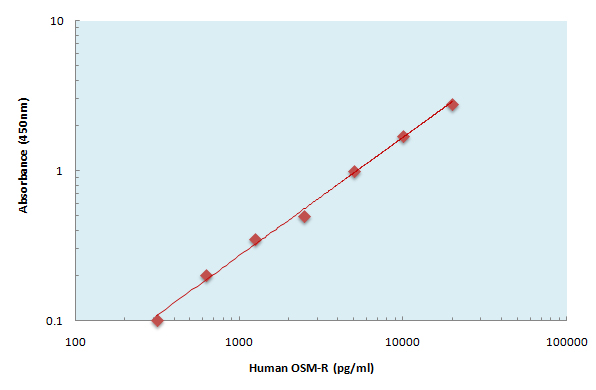Human OSM-R ELISA Kit
- Catalog No.:KE1157
- Applications:ELISA
- Reactivity:Human
- Gene Name:
- OSMR
- Protein Name:
- Oncostatin-M-specific receptor subunit beta
- Human Gene Id:
- 9180
- Human Swiss Prot No:
- Q99650
- Mouse Swiss Prot No:
- O70458
- Specificity:
- Sample Type for Cell Culture Supernates, Cell lysates, Tissue Lysates, Serum, EDTA Plasma, Heparin Plasma
- Storage Stability:
- 2-8°C/6 months
- Other Name:
- OSMR;OSMRB;Oncostatin-M-specific receptor subunit beta;Interleukin-31 receptor subunit beta;IL-31 receptor subunit beta;IL-31R subunit beta;IL-31R-beta;IL-31RB
- Detection Method:
- Colorimetric
- Background:
- disease:Defects in OSMR are the cause of amyloidosis type 9 (AMYL9) [MIM:105250]; also known as primary cutaneous amyloidosis (PCA), primary localized cutaneous amyloidosis (PLCA), familial lichen amyloidosis or familial cutaneous lichen amyloidosis. AMYL9 is a hereditary primary amyloidosis characterized by localized cutaneous amyloid deposition. This condition usually presents with itching (especially on the lower legs) and visible changes of skin hyperpigmentation and thickening (lichenification) that may be exacerbated by chronic scratching and rubbing. The amyloid deposits probably reflect a combination of degenerate keratin filaments, serum amyloid P component, and deposition of immunoglobulins.,domain:The box 1 motif is required for JAK interaction and/or activation.,domain:The WSXWS motif appears to be necessary for proper protein folding and thereby efficient intracellular transport and cell-surface receptor binding.,function:Associates with IL31RA to form the IL31 receptor. Binds IL31 to activate STAT3 and possibly STAT1 and STAT5. Capable of transducing OSM-specific signaling events.,induction:Activated by oncostatin-M. Up-regulated by IFNG and lipopolysaccharide.,similarity:Belongs to the type I cytokine receptor family. Type 2 subfamily.,similarity:Contains 4 fibronectin type-III domains.,subunit:Heterodimer composed of OSMR and IL6ST (type II OSM receptor). Heterodimer with IL31RA to form the IL31 receptor.,tissue specificity:Expressed at relatively high levels in all neural cells as well as fibroblast, epithelial and a variety of tumor cell lines.,
- Function:
- regulation of acute inflammatory response, positive regulation of acute inflammatory response, cell surface receptor linked signal transduction, cell proliferation, positive regulation of cell proliferation, response to organic substance,positive regulation of defense response, regulation of response to external stimulus, positive regulation of response to external stimulus, response to cytokine stimulus, regulation of cell proliferation, positive regulation of response to stimulus, regulation of inflammatory response, positive regulation of inflammatory response,
- Subcellular Location:
- Membrane ; Single-pass type I membrane protein .
- Expression:
- Expressed in keratinocytes (at protein level) (PubMed:21261663). Expressed at relatively high levels in all neural cells as well as fibroblast and epithelial cells (PubMed:8999038).
- June 19-2018
- WESTERN IMMUNOBLOTTING PROTOCOL
- June 19-2018
- IMMUNOHISTOCHEMISTRY-PARAFFIN PROTOCOL
- June 19-2018
- IMMUNOFLUORESCENCE PROTOCOL
- September 08-2020
- FLOW-CYTOMEYRT-PROTOCOL
- May 20-2022
- Cell-Based ELISA│解您多样本WB检测之困扰
- July 13-2018
- CELL-BASED-ELISA-PROTOCOL-FOR-ACETYL-PROTEIN
- July 13-2018
- CELL-BASED-ELISA-PROTOCOL-FOR-PHOSPHO-PROTEIN
- July 13-2018
- Antibody-FAQs
- Products Images

- The Human OSM-R ELISA Kit allows for the detection and quantification of endogenous levels of natural and/or recombinant Human OSM-R proteins within the range of 313-20000 pg/ml.



